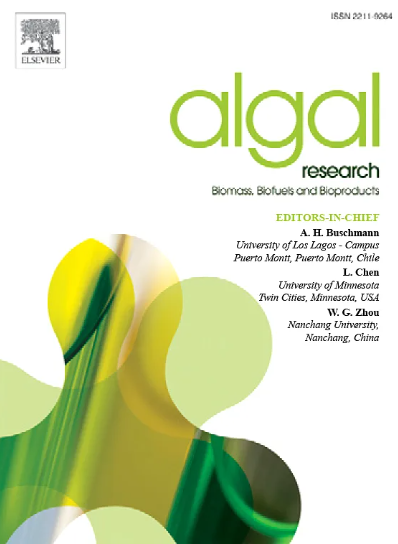Techno-economic analysis of bioplastic and biofuel production from a high-ash microalgae biofilm cultivated in effluent from a municipal anaerobic digester
IF 4.6
2区 生物学
Q1 BIOTECHNOLOGY & APPLIED MICROBIOLOGY
Algal Research-Biomass Biofuels and Bioproducts
Pub Date : 2024-10-26
DOI:10.1016/j.algal.2024.103774
引用次数: 0
Abstract
Rotating Algae Biofilm Reactors (RABRs) are a promising technology for efficient treatment of wastewater and production of algae-based bioproducts. However, RABR-grown algae can contain a high content of ash (30–60 wt%, dry basis), which influences the technical and economic feasibility of bioproduct conversion processes. In this report, experimental studies and economic analysis were conducted to compare different processes for bioproduct conversion of a high-ash microalgae biofilm grown using a RABR treating 0.6 million gallons per day of anaerobic digestion centrate at the Central Valley Water Reclamation Facility in Salt Lake City, UT. Process and economic models were developed and compared for three conversion processes: 1) the production of bioplastics, 2) the production of bioplastics with a lipid-extraction pretreatment, and 3) the production of biocrude via hydrothermal liquefaction. Techno-economic analysis was performed for each conversion process, including three cases for algae productivity: 231, 391, and 577 metric tons per year (dry basis). The calculated value for the minimum plastic selling price (MPSP) of bioplastics produced from algae ranges from $4050 to $3520 per metric ton based on the baseline and final productivity cases of the RABR, respectively. The extraction of lipids in addition to bioplastic production results in an MPSP of $4570 to $4000 per metric ton for the same productivity cases. The relatively small production scale and complex processing for hydrothermal liquefaction results in a minimum fuel selling price of the biocrude of $5.32 per gallon of gasoline equivalent. The conversion process for bioplastic production from whole algae has the highest income:expense ratio and the most cost-competitive pricing of the three modeled processes.

利用市政厌氧发酵池污水中培养的高灰分微藻生物膜生产生物塑料和生物燃料的技术经济分析
旋转藻类生物膜反应器(RABRs)是一种很有前途的技术,可用于高效处理废水和生产藻类生物产品。然而,RABR 生长的藻类可能含有较高的灰分(30-60 wt%,干基),这影响了生物产品转化过程的技术和经济可行性。在本报告中,我们进行了实验研究和经济分析,比较了在犹他州盐湖城中央谷水回收设施中使用 RABR(每天处理 60 万加仑厌氧消化中心液)生长的高灰分微藻生物膜进行生物产品转化的不同工艺。针对三种转换工艺开发并比较了工艺和经济模型:1) 生产生物塑料;2) 通过脂质提取预处理生产生物塑料;3) 通过水热液化生产生物原油。对每种转化工艺都进行了技术经济分析,包括藻类生产力的三种情况:每年 231、391 和 577 公吨(干基)。根据 RABR 的基准和最终生产率情况,藻类生产的生物塑料的最低塑料销售价格(MPSP)计算值分别为每公吨 4050 美元至 3520 美元。在生产率相同的情况下,除生产生物塑料外还提取脂类,则每公吨的 MPSP 为 4570 美元至 4000 美元。由于生产规模相对较小,水热液化工艺复杂,生物原油的最低燃料售价为每加仑汽油当量 5.32 美元。在三种模拟工艺中,利用整株藻类生产生物塑料的转化工艺具有最高的收支比和最具成本竞争力的定价。
本文章由计算机程序翻译,如有差异,请以英文原文为准。
求助全文
约1分钟内获得全文
求助全文
来源期刊

Algal Research-Biomass Biofuels and Bioproducts
BIOTECHNOLOGY & APPLIED MICROBIOLOGY-
CiteScore
9.40
自引率
7.80%
发文量
332
期刊介绍:
Algal Research is an international phycology journal covering all areas of emerging technologies in algae biology, biomass production, cultivation, harvesting, extraction, bioproducts, biorefinery, engineering, and econometrics. Algae is defined to include cyanobacteria, microalgae, and protists and symbionts of interest in biotechnology. The journal publishes original research and reviews for the following scope: algal biology, including but not exclusive to: phylogeny, biodiversity, molecular traits, metabolic regulation, and genetic engineering, algal cultivation, e.g. phototrophic systems, heterotrophic systems, and mixotrophic systems, algal harvesting and extraction systems, biotechnology to convert algal biomass and components into biofuels and bioproducts, e.g., nutraceuticals, pharmaceuticals, animal feed, plastics, etc. algal products and their economic assessment
 求助内容:
求助内容: 应助结果提醒方式:
应助结果提醒方式:


